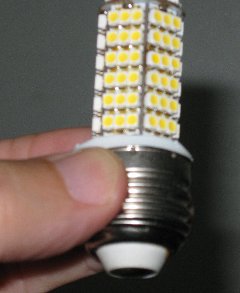Lighting For Emergency Communications
I use a dedicated 12 volt DC system to power as much as possible, such as my communications rigs, and also my lighting system.
12 Volts is versatile, as you can use a deep-cycle battery system charged by solar panels, wind generation or even a heavy DC power supply/charger driven by a gas AC generator. I also run a 12 volt system because you never have to “power down” like you need when you re-fill a gas generator. You can switch batteries very easily without interruption.
 I have experimented with all types of 12 volt lighting methods and have come to the conclusion that a system using SMD (surface mounted light emitting diodes) gives you the most illumination per watt. Using other 12 volt lights, such as fluorescent systems, can have a high rate of failure. You don’t want your lighting to go out in the middle of emergency work.
I have experimented with all types of 12 volt lighting methods and have come to the conclusion that a system using SMD (surface mounted light emitting diodes) gives you the most illumination per watt. Using other 12 volt lights, such as fluorescent systems, can have a high rate of failure. You don’t want your lighting to go out in the middle of emergency work.
I have had these fluorescent lights “blow” after only about 10 hours and it’s usually the electronics package built into each lamp that burns out because it’s electronics has to convert 12 volts DC into high voltage in order to make the bulb fluoresce (ignite) and the imported lamps (usually made in China or Hong Kong) are made with sub-standard components.
Most SMD systems, even though they are imported as well, last as long as 50,000 hours and aren’t as fragile as either fluorescent bulbs or other glass lights. You drop a fluorescent blub on the floor and it breaks in to a hundred shards of glass with dangerous chemicals on them…. you drop an SMD light on the floor and all you have to do is pick it up.
 The SMD lights shown in this article, emit as much as 720 lumens, meaning just one of these lights can illuminate an operating tent and use as little as 5 watts! The ones I use have over 100 emitters in each light.
The SMD lights shown in this article, emit as much as 720 lumens, meaning just one of these lights can illuminate an operating tent and use as little as 5 watts! The ones I use have over 100 emitters in each light.
As a matter of fact, in my home, which I wired for 12 volt solar power, just two of these lights will illuminate my living room quite nicely. The picture on the right shows one of these lights that I have modified to fit in a standard Edison-base socket. (NO, do not try to use these in a 110 volt system, my 12 volt lighting system uses this base as well) Of course, your wiring must include a safety fuse in line with the lights.
This is the lighting system I use during emergency communications deployment and if you are a part of the “Jump Team Boot Camp” you’ll see them in action.
To light a large outdoor area, I use a “CREE” spot light which is the size of a postage stamp yet can light an out door area about 50×100 feet. CREE is also a form of SMD lighting that uses very little in the way of power. I use just one of these CREE spots to illuminate the entire camp/communications area. It has a light output of about 1800 lumens with a rear reflector. Again, you’ll see one of these CREE spots during the “Jump Team Boot Camp”.
I will be posting other suggestions on effective methods of EMCOMM deployment as in my “Jump Team Boot Camp class” as time permits.
